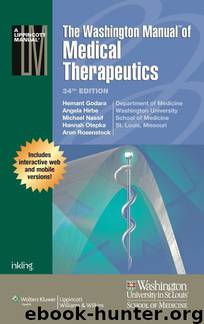The Washington Manual of Medical Therapeutics by Godara Hemant

Author:Godara, Hemant [Godara, Hemant]
Language: eng
Format: epub
ISBN: 9781451188516
Publisher: Lippincott Williams & Wilkins
Published: 2013-06-10T00:00:00+00:00
16
Human Immunodeficiency Virus and Acquired Immunodeficiency Syndrome
Sara L. Cross and E. Turner Overton
HIV Type 1
GENERAL PRINCIPLES
Definition
Human immunodeficiency virus (HIV) type 1 is a retrovirus that predominantly infects lymphocytes that bear the CD4 surface protein, as well as coreceptors belonging to the chemokine receptor family (CCR5 or CXCR4), and causes acquired immunodeficiency syndrome (AIDS).
Classification
The Centers for Disease Control (CDC) classification is based on the CD4 count and presence of AIDS-associated conditions. Diagnosis of AIDS is made on the basis of CD4 cell count <200, CD4 percentage <14%, or development of one of the 25 AIDS-defining conditions (MMWR 1992;41(RR-17)).
Epidemiology
• HIV type 1 is common throughout the world. By the most recent estimates, over 34 million people worldwide are living with HIV or AIDS with a significant burden of disease in Sub-Saharan Africa (http://www.who.int/hiv/data/en/index.html).
• In the United States, 1.3 million people are estimated to be infected with HIV with one-fourth of these persons unaware of their infection. The CDC estimates that as many as 70% of the 50,000 new annual infections in the United States are transmitted by persons who are unaware of their HIV status.
• Despite comprising only 14% of the population in the United States, African Americans are disproportionately affected by HIV, accounting for nearly 44% of all new cases of HIV in this country. Hispanics are also disproportionately affected by HIV. Women comprise approximately 24% of the U.S. epidemic (http://www.cdc.gov/hiv/topics/women).
Men who have sex with men (MSM) remain the population most heavily affected by HIV in the United States. Of all new HIV infections in 2009, 61% were MSM (http://www.cdc.gov/nchhstp/newsroom/docs/HIV-Infections-2006-2009.pdf).
• HIV type 2 is endemic to regions in West Africa. It is characterized by much slower progression to AIDS and resistance to nonnucleoside reverse transcriptase inhibitors (NNRTIs).
Etiology
After entering the host cell, HIV utilizes reverse transcriptase, transcribing viral RNA into DNA, which integrates into the host DNA. The host cell machinery is then used to produce the relevant viral proteins, which are appropriately truncated by a viral protease. Infectious viral particles bud away to infect other CD4 lymphocytes before the infected cell is destroyed by the immune system. Infection usually leads to CD4 T-cell depletion, and impaired cell-mediated immunity.
Pathophysiology
Without highly active antiretroviral therapy (HAART), the immune dysfunction progresses to AIDS, which is characterized by development of opportunistic infections (OIs), malignancies, and wasting. The time from acute HIV infection to development of AIDS varies from months to years (depending on host and viral factors), with a median latency period of 10 years.
Risk Factors
The virus is primarily transmitted sexually but also parenterally and perinatally.
Download
This site does not store any files on its server. We only index and link to content provided by other sites. Please contact the content providers to delete copyright contents if any and email us, we'll remove relevant links or contents immediately.
Periodization Training for Sports by Tudor Bompa(8171)
Why We Sleep: Unlocking the Power of Sleep and Dreams by Matthew Walker(6618)
Paper Towns by Green John(5092)
The Immortal Life of Henrietta Lacks by Rebecca Skloot(4526)
The Sports Rules Book by Human Kinetics(4296)
Dynamic Alignment Through Imagery by Eric Franklin(4118)
ACSM's Complete Guide to Fitness & Health by ACSM(3989)
Kaplan MCAT Organic Chemistry Review: Created for MCAT 2015 (Kaplan Test Prep) by Kaplan(3940)
Introduction to Kinesiology by Shirl J. Hoffman(3726)
Livewired by David Eagleman(3685)
The Death of the Heart by Elizabeth Bowen(3553)
The River of Consciousness by Oliver Sacks(3542)
Alchemy and Alchemists by C. J. S. Thompson(3451)
Bad Pharma by Ben Goldacre(3357)
Descartes' Error by Antonio Damasio(3230)
The Emperor of All Maladies: A Biography of Cancer by Siddhartha Mukherjee(3068)
The Gene: An Intimate History by Siddhartha Mukherjee(3048)
The Fate of Rome: Climate, Disease, and the End of an Empire (The Princeton History of the Ancient World) by Kyle Harper(3003)
Kaplan MCAT Behavioral Sciences Review: Created for MCAT 2015 (Kaplan Test Prep) by Kaplan(2941)
